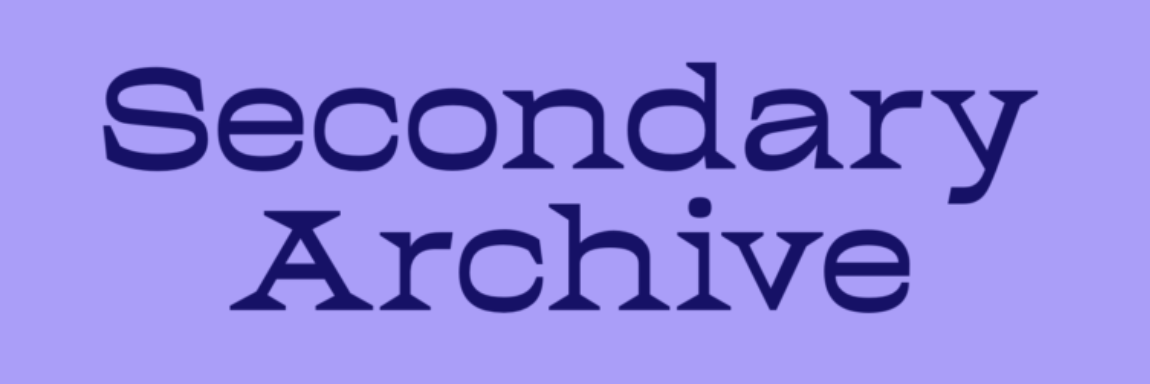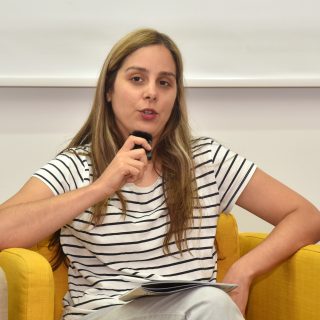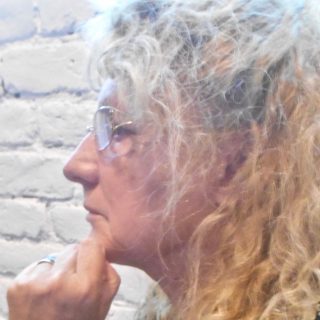Conversation between the Secondary Archive Kosovo curators Erëmirë Krasniqi and Renea Begolli
Erëmirë: You are an artist yourself Renea. How much did you know about women artists of different generations in Kosovo prior to the curation of the Secondary Archive project?
Renea: To be honest, I did not know much, especially not before I practiced art more professionally. It is weird to think about how little information was handed to me. Even when I wanted to conduct research, I could not find any reading materials or similar to look at the works of older generations of women artists. During my studies at the University of Prishtina, I had this question about who the women artists of Kosovo were. I do not remember having actually had any lecture that focused more on Kosovo artists, especially on women. One way of learning about them was through exhibitions, as more or less the only source of accessing visual and factual information.
Erëmirë: What were those formative exhibitions that provided you with some insight on local women artists?
Renea: For example, I remember Alije Vokshi’s solo show in 2018 at the Gallery of the Ministry of Culture vividly. It was the first time I saw her paintings up close. I saw her portraits, brush strokes, and colors that she used. I realized how important it was to see the works up close and to understand what the artist wanted to capture from her life. At the beginnings of the National Gallery Kosovo, she was one of the few women of her generation who had a solo show, or was part of the art collection of the National Gallery. So for me, it was necessary to get introduced to her work and to have more context on who this woman who presented her works in a male-dominated art scene was. Then there was Perceptions: Burrneshat and later Ambitions, both survey exhibitions. What struck me were the various approaches and multi-dimensional takes on important topics, but also depending on what generation they belonged the uses of media were very diverse. However, seeing their artworks in a collective exhibition felt like a sneak peek.
For some time now I have the sense that there should be more exhibitions focusing on women because in that way they come to the surface and take the spotlight. I noticed this disproportion of representation when the exhibition included both genders. Especially during the Secondary Archive project, I came to understand that the lack of visibility was not due to the lack of creativity, talent, or professionalism, but due to the lack of inclusivity instituted by institutions such as the National Gallery, media, and their close circles. So, most of the time, these women were left out of public sight and the institutional sexism excused the lack of representation. That perpetuated the idea that these women were not complex individuals too, with their agency, personality, artistic integrity, and so on.
Erëmirë, you also did research as part of your curatorial work on Kosovo women artists prior to the Secondary Archive project. I would guess you went through different processes of collaborating with the artists, right?
Erëmirë: Obtaining information on women artists is always difficult. It is true that the exhibition Secondary Archive was not my entry point. When I co-curated the exhibition Ambitions for the National Gallery of Arts in Albania and Kosovo in 2021, I wanted to expand the history of women in the arts and researched throughout 2020. In the process, I consulted exhibition catalogs that the National Gallery of Kosovo had archived through the years, and various publications. I also read through and through the culture section of Rilindja newspaper from the ‘60s and onwards.
To go even further back, in 2016, I did an oral history project with artists of different generations of the socialist modernist era. Even then, diversifying the pool of interviewees became difficult to achieve. I was interviewing only men. There were no women artists, or better put, the formal criteria I used to qualify women as artists was not precise. When you adopt the popular view and expect women to have the same artistic career trajectory as men, it not only is unrealistic but also presents women as lacking, as not-quite-there-yet, as non-artists. So, by placing importance on the cultural conditions within which they produced works of art, which were deeply patriarchal and posed many obstacles to women to participate in public life, I got a glimpse of how gender biased the criteria was to begin with.
So, the formal criteria: how many solo or group shows women artists had or how many critical texts were written about their work of art. That is not an adequate way to go about it. The moment I got rid of that type of normative thinking that placed men and their experience at the center, it opened up new ways of thinking about women’s heritage in the arts. Despite difficulties to trace them in literature, exhibition catalogs and historical records, their number increased. It was not just one female artist as I initially thought, but a handful of them.
Renea: What did you observe going through the archives and then coming back to working with them in writing statements for the Secondary Archive? What were some of the novelties that you witnessed through the Secondary Archive project?
Erëmirë: Well, I did not get much by going to public archives. However, I got a lot as I went through their private archives. Sitting with them in their studios or kitchens and having conversations or conducting interviews with them, I managed to obtain a wide array of sources to position their work in today’s context. In the process of having artists write statements for the Secondary Archive, I became a better facilitator for them, because I understood the importance of handling first-person writing that concerned life, career, and politics. It took a lot of trust building. For many, as I came to understand, it was difficult. Yet at the same time, it was important to write from the position of a first-person narrative and start the sentence with “I.”
Come to think of the novelties that the process introduced, the Secondary Archive got me out of the issues of the past a bit (though not entirely, as some issues still persist). It gave me access to many great women artists living and working in Kosovo and its diaspora. I identify with many of the questions they have about the context and how it reflects and interjects in their artistic practice. I like and admire how unapologetic the younger generation is and the ease with which they find their center and articulate their subjecthood and position themselves as artists.
But speaking of the important issues that we identified, Renea, do you think there were issues that the older generation of artists dealt with, while the younger generation no longer has to?
Renea: I think that the multiple political transitions impacted the way these artists created and thought about their life and work. The archive starts with the first generation of women who received an art education, who were part of the modernist era in Kosovo. Their experience spans in the ‘60s, ‘70s, and ‘80s in the socialist system of former Yugoslavia. This generation witnessed the establishment of key art institutions. Some of these women were part of these institutions but not involved as much in the process of decision-making. So, I think one of the main difficulties for women was the exclusion in the institutions and their lack of representation. And that way of thinking caused many insecurities about the qualities of their works and their conceptualization.
Erëmirë: Yes, that’s true. As the main art institution of the visual arts and gatekeeper of a tradition in Kosovo, the Gallery’s management reflected very little on the absence of women within their exhibition and public programs. Their public programming in the first decade was structured around Yugoslav artistic collaborations, international exhibition exchanges, such as Yugoslav Drawings Biennial (1974), the Yugoslav Photography Biennial (1976), the Slovenian days of culture (1977), and the Polish visual arts exhibition (1978); and solo exhibitions by male local artists, hence positioning them locally as “Old Masters”. This is something that we still encounter and deal with nowadays. During those formative years of the institution, there was an attempt to create a cultural identity for Kosovo. However, it was based on the experience of male artists solely. By being structurally excluded, women could not play a great part in defining what was eventually known as the modern art in Kosovo.
Renea: Yes, then everything changed with the revocation of Kosovo’s autonomy in Yugoslavia. With the citizen-led system that was organized in the 1990s, a new generation of women artists came to the fore. The artists of this generation had a different sense of urgency and it was very important to them to be part of the peaceful resistance, and often their artworks took the form of a protest. Finding ways to secure alternative exhibition spaces also involved more women artists. Somehow, being outside of institutions did away with traditional gatekeepers. On the other hand, another generation of artists arrived in post-war Kosovo. Women of this generation are more subjective and explore new media. Then there is the diaspora, which brings different themes and perspectives on belonging, homeland, and identity that is very much present in their works.
For many, the issue of exteriorizing themselves through the writing medium became a bit of a problem. Writing has a public dimension that is different from exhibiting, and I thought they were not used to it. As we said over and over, not much has been written about women artists and it was not a simple process to enter writing and rehearse that sense of “I” that you mentioned.
Overall, the process made us realize that documentation of this kind is very important due to the lack of accessible resources, both online and offline, on women artists in Kosovo. So, how do you think this type of archiving expands our understanding of artists, gender roles, and archiving?
Erëmirë: The Secondary Archive is a great resource to conduct research on women artists in Central and Eastern Europe. It covers close to ten countries and uses throughout the same documentation and archiving approach. It is online and open-access. The archive has gathered hundreds of artistic statements, biographies, and documented practices by women artists. It showcases three generations of women in art – both internationally recognized women, and those who remain unknown. There has been a historical silence surrounding artists and curators, historians and theorists from this part of the world. Thus, the archive ensures that women have a voice and shape art discourses.
In July 2021, the Oral History Initiative partnered with the Secondary Archive. As part of our ambition to advocate for and support the essential work of media archives, we joined in their effort to expand art research, digital infrastructure, and geographical reach. Thereby, we helped them create a more inclusive platform that captures the experiences of women artists in Central and Eastern Europe. By July 2022, the archive accommodated over 400 women artists from Albania, Belarus, Czechia, Hungary, Kosovo, Poland, Serbia, Slovakia, and Ukraine.
The Secondary Archive is intended as a dialogue between artistic positions of women of different generations and geographies. The dissonant historical temporalities brought forward by the artists’ statements encourage new modes of narrating and relation building, and with that, a different kind of history-writing. Moreover, it reflects the diversity and complexity of the region, which is often perceived as culturally homogeneous. The statements are in the artists’ native languages and English.
The archive also brings attention to what was lacking in the art discourse. It gives visibility to women, regions, contested borders, languages, and narratives that remain under the radar. As such, it is a great reminder that we should not ignore the existing multiplicity of experiences but instead, highlight the many narratives, stories, and paths. The archive explores cultural facets of these countries and brings to the center the intangible practices and knowledge, which are intimately connected to women’s experiences in the arts. As such, it works with a history that has few or no tangible traces left. Therefore, I hope that your generation finds the archive of use and takes it from here, Renea.
Renea: Yes, I hope so too. There is still much work to be done and our goal is to further expand the archive with even more artists that had their doubts or hesitated to join the first time around.
Erëmirë Krasniqi is an art writer, curator, and researcher based in Prishtina, Kosovo. Erëmirë received her M.A. from Dartmouth College and B.A. from Bard College Berlin. She attended a year-long postgraduate program in curation and museology at Friedrich Schiller Jena University. Her writing has been published in Kosovo 2.0, frieze and Artforum. As an independent curator, she has led and curated projects for the National Gallery of Kosovo, the National Gallery of Arts in Albania, 39th EVA International, Ireland, and Manifesta 14, Kosovo. Her research practice is at the intersection of contemporary art, digital humanities, and cultural heritage. Erëmirë is the executive director of Oral History Initiative, an open-access digital resource that engages new forms of cultural production, supporting and advocating the essential work of media archives.
Renea Begolli is a visual artist and researcher based in Prishtina, Kosovo. Renea graduated from the Department of Painting at the Faculty of Arts, University of Prishtina. During her Bachelor studies, she spent a semester at the Department of Sociology and Social Anthropology at Bournemouth University, England. In 2020, she joined the Oral History Initiative, where she works as a researcher and archivist. As an artist, Renea was part of numerous group art shows as well as solo shows.




